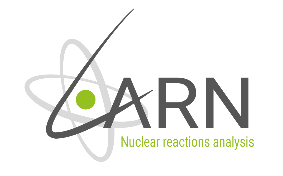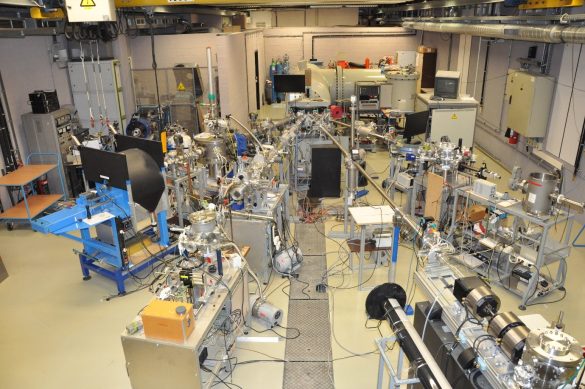 The LARN (“Laboratoire d’Analyse par Réactions Nucléaires”) is a research and development laboratory of the University of Namur housing a 2 MV Tandem accelerator (ALTAÏS) from High Voltage Engineering Europa (commissioned in 1998). Thanks to its two ions sources (SNICS 860 & Duoplasmatron 358) ALTAÏS can provide ion beams of almost any stable elements with an incident energy ranging from a few keV to 16 MeV.
The LARN (“Laboratoire d’Analyse par Réactions Nucléaires”) is a research and development laboratory of the University of Namur housing a 2 MV Tandem accelerator (ALTAÏS) from High Voltage Engineering Europa (commissioned in 1998). Thanks to its two ions sources (SNICS 860 & Duoplasmatron 358) ALTAÏS can provide ion beams of almost any stable elements with an incident energy ranging from a few keV to 16 MeV.
The LARN has a long history in applying IBMM & IBA techniques in various research fields including functional (nano)materials, functional coatings, microelectronics, photovoltaics, batteries, cultural heritage… Over the last few years, we have developed skills to handle a wide range of samples (metals, welds, glass, polymers, powders, liquids, in-vivo biological materials, aerosols, cultural heritage artefacts…). Our analytical capabilities have recently been strengthened with the commissioning of a µ-probe from Oxford Microbeams (that we are currently setting up to carry out standard IBA at atmospheric pressure). We have also developed a very low-background gamma-ray detection system allowing us to measure low-level radioactive materials or pushing PIGE to its best sensitivity.
Finally, we have dedicated an end-station to life science research. With the help of a multidisciplinary team, we study experimentally and theoretically the cells response to photons (X-ray) or particles (H, He or C) irradiation. We are also able to synthesize nanoparticles and study the cells response to their exposure.
LARN’s areas of competence:
- Standard IBA (RBS, ERD, NRA, PIGE, PIXE) with broad- or micro-beam.
- Low-background gamma-ray detection
- Cells irradiation: proton (from 1,3 to 4 MeV), alpha (5,3 MeV) and carbon(12 MeV)
- Low- (1.5 – 36 keV) and medium- (0.15 – 16 MeV) energy ion implantation
Ion Beam Implantation:
| Parameter | Description |
|---|---|
| Ion species | H - Au (stable nuclides, poly-atomic ions) |
| Ion energy | 150 keV - 16 MeV |
| Depth range | typically 1 - 150 µm |
| Fluence | 1014 - 1018 cm2 |
| Incidence angle | Standard 0°, 7° |
| Beam current | 100 nA - 10 µA |
| Beam size | 1 cm2 |
| Sample size | Typically 2 cm2 |
| Temperature | room temperature |
| Parameter | Description |
|---|---|
| Ion species | H - Au (stable nuclides, poly-atomic ions) |
| Ion energy | 3 keV - 36 keV |
| Depth range | typically 0.1 - 5 µm |
| Fluence | 1014 - 1018 cm-2 |
| Incidence angle | Standard 0° |
| Beam current | 1-10 µA |
| Beam size | 6 x 12 mm2 |
| Sample size | Typically 2 cm2 |
| Temperature | room temperature |
Ion Beam Analysis:
| Method | Elements | Detection limit [at%] | Resolution depth | Resolution lateral | other |
|---|---|---|---|---|---|
| RBS / EBS | C - U | 0.1 | 10 nm | 1 mm (broad beam) 1 µm (micro beam) | 5 axis sample holder |
| ERDA | H | 0.1 | 15 nm | 1.5 mm | 5 axis sample holder |
| PIXE | Na - U | 0.0001 | 15 µm | 1 mm (broad beam) 1 µm (micro beam) | 5 axis sample holder |
| NRA | H, B, C, N, F, O, … | 0.001 | 5 nm | 1 mm (broad beam) 1 µm (micro beam) | 5 axis sample holder |
Cells Irradiation:
| Parameters | Description |
|---|---|
| Dose rate (Gy/s) | 0,01-1000 |
| ions | p (from 1,3 to 4 MeV), alpha (5,3 MeV) and carbon(12 MeV) |
| beam size | ~1 cm² |
| special features | possibility of pulsed beam |
Low-Background system:
| Method | Elements | Detection limit [at%] | Resolution depth | resolution |
|---|---|---|---|---|
| RNRA/PIGE (gamma detection) | H, C, F,… | 0.005 | ~nm | ~mm |
| Method | volume of sample | Background count rate (0,3-3,0 MeV ; cps) | Background count rate (3,0-66,0 MeV ; cps) | Energy resolution |
|---|---|---|---|---|
| radioactivity analysis | ~1dm³, solid or liquid | 0,5 | 0,4 | 1,9 keV à 1332 keV |
Photos:
Address:
LARN
University of Namur
61 rue de Bruxelles
5000 Namur
Belgium
